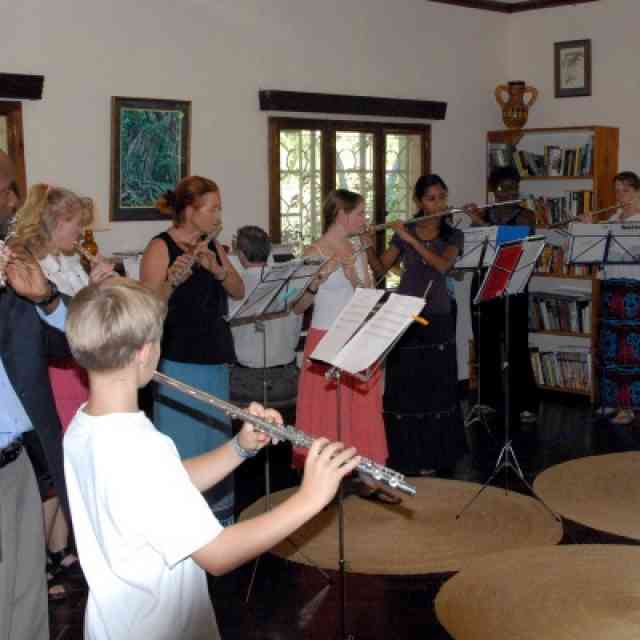by Margaret Schmidt
An Unexpected Detour
Do you remember the song “Hakuna Matata” from The Lion King? It’s Swahili for “no worries,” or a reminder to just go with the flow, no matter what happens. It’s a good motto for when things don’t go as planned. As an inveterate planner of everything from my teaching to my “free” time, hakuna matata is always a challenge for me. I like to know what’s coming. A little over a year ago, I began a new journey of discovery as a retired string teacher educator. I had spent my life teaching, from leading songs at Girl Scout Camp as a teenager, to fourteen years teaching elementary and middle school orchestra, to twenty-eight years as a college professor preparing young K–12 teachers. I wanted to do something special to mark the beginning of this new retirement adventure, so I planned a trip to Machu Pichu, Peru. By early 2023, it became evident that the political situation in Peru would make that trip unsafe, and I began looking for something else.
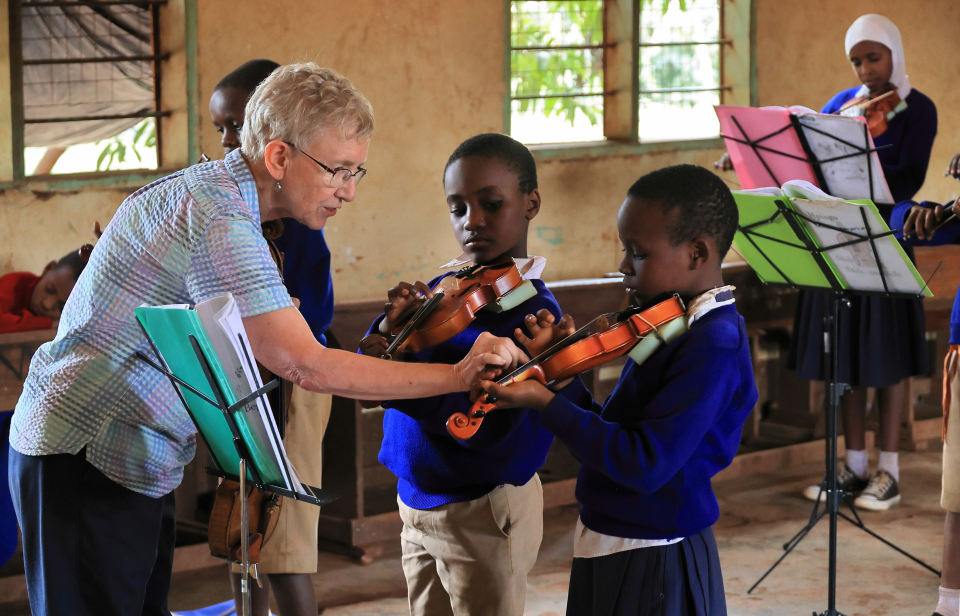
The author working with students at the Majengo Elementary School in Moshi, Tanzania. Photo by Allan Blunt.
A colleague sent me an announcement about volunteer opportunities with the Daraja Music Initiative (DMI). I had heard occasional mention of this non-profit group, founded in 2010 as Clarinets for Conservation by a graduate student at my university, Arizona State. I checked out the website and was immediately intrigued by the interdisciplinary focus on sharing music and conserving the mpingo, the national tree of Tanzania. Other names for the mpingo are African blackwood, grenadilla, or ebony, and the wood has been a source for making clarinets, oboes, and string fingerboards, as well as over 5000 years of fine African carving traditions. Michelle van Haugg, founder, was inspired by the 1992 BBC Wildlife film, The Tree That Makes Music, which explained the conditions conspiring to limit the sustainability of mpingo growth: climate change, overharvesting, and not planting enough replacement trees, similar to the concerns about vanishing supplies of pernambuco wood in Brazil. She established connections with the African Blackwood Conservation Project in Moshi, Tanzania, and began working to plant trees at schools in the area. To help local children understand the value of the mpingo, DMI volunteers also began teaching clarinet at some of the schools; strings were added in 2014 by Hilary Herndon, faculty at the University of Tennessee-Knoxville.
So hakuna matata! One of my favorite ways to travel is to stay in a place long enough to learn what everyday life is like for the people there. Although I had never thought about going to Africa, the DMI opportunity seemed to fill that bill, with the added perks of being able to teach strings and go on a safari. I attended an information meeting on Zoom and immediately signed up to volunteer for two weeks. DMI board members provided plenty of information to help volunteers prepare for the trip. Even though the travel time to Moshi was long, it was wonderful to know I would be greeted at the Kilimanjaro airport by board member and volunteer Ian Tyson, and driven directly to Jacaranda House, which became my home for the next two weeks.
Teaching at Majengo Elementary School
Even the best preparation can never provide a sense of what being there is like. The program was rebuilding this year, after a three-year break for the pandemic, so we taught only at one school, Majengo Elementary. During the two weeks I was there, I worked with eight volunteers, five from the US and three Tanzanians. We walked to the school every afternoon and collaboratively taught three classes. We had a thirty-minute general music class with a group of about twenty children who seemed to be about third-grade age. We sang mostly American folk songs and solfege with hand signs. We learned a few Swahili words to facilitate instruction; the students loved “Hokey Pokey” and singing “Head, Shoulders, Knees and Toes” tena (again) and haraka (faster). Then we had a thirty-minute general music class with the students who were learning clarinet and violin, where we worked on rhythms and standard notation using a variety of hands-on activities. On Wednesdays, both classes did a conservation activity instead of music, such as writing poems, drawing pictures about the environment, or picking up trash in the school yard.
Following the second general music class, those students continued with an hour of clarinet or violin class. The school selected the students who could participate in the program, and the students got to choose either clarinet or violin. I arrived in the fifth week of the program, so the students in the violin class were already well set up by board member Roselyn Hobbs. She taught for the first three weeks with two Tanzanian young men, Fraterin Shayo and Michael Boaz, and they kept the class moving forward until I arrived.
As an experienced teacher, I was concerned about stepping in to teach a class of beginners who had already been going for five weeks with other teachers. Students get used to certain vocabulary and procedures, and I knew it could be chaos if I didn’t continue using the same ones. Fortunately, Roselyn was very willing to answer my many questions. She shared her daily lesson plans and also sent me the Suzuki-based teacher’s guide. (Ching-Yi Lin developed a very thorough curriculum guide in the summers of 2016 and 2017, when she led college students and others to teach in Moshi.) Although I am not a trained Suzuki teacher, I knew enough about the pedagogy that, by the time I arrived, I thought I could easily fit in.
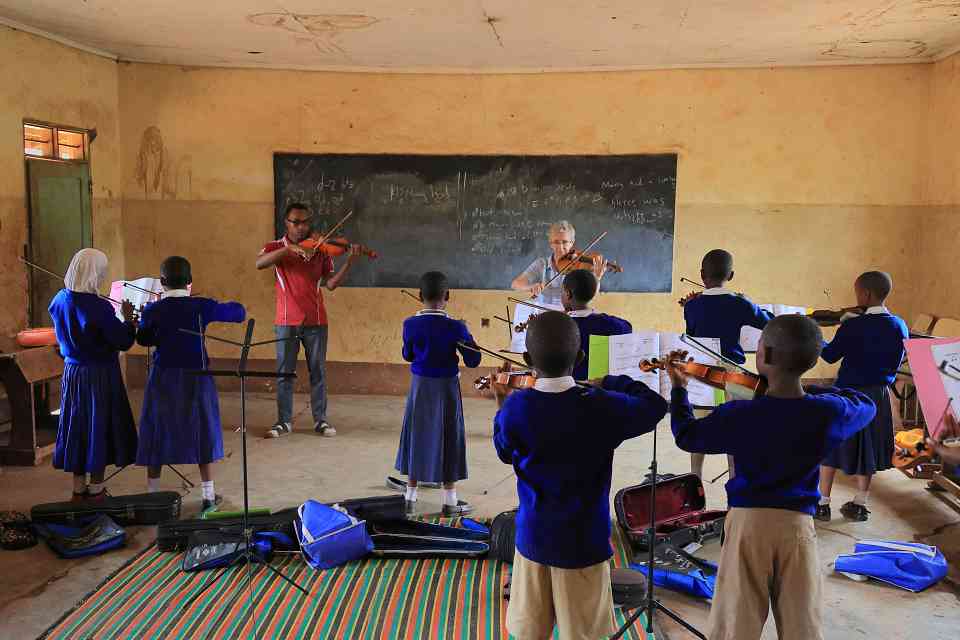
The author (front right) teaching with Michael Boaz (front left) at the Majengo Elementary School in Moshi, Tanzania. Photo by Allan Blunt.
The first two days, I just observed the classes. I was uncertain what my role was in relation to Michael and Fraterin. They were very welcoming, immediately calling me by the common honorific for older women, “Bibi” or “Grandma.” We could communicate reasonably well in English, and they were both very eager for my help in improving both their violin playing skills and pedagogy. As they led the class, I noticed that they were doing things common to many young teachers, such as talking too much and explaining instead of demonstrating. I decided to model some other teaching strategies they could use, explaining after class why I did those things, and they caught on quickly. As they gained skill, I encouraged them to do more of the teaching, and my role evolved into more like a coach.
With my limited Swahili, lots of gesturing and modeling, and translations as needed by Fraterin and Michael, teaching the Majengo students was remarkably like teaching anywhere. A group of students was usually waiting when we arrived, and they jostled for the opportunity to carry our instruments and backpacks to the classroom. Students kept their instruments at school, but with a daily one-hour class they were able to get lots of repetition and make good progress. The biggest difference was the students’ motivation and focus. I was amazed at their ability to focus from 3:30 to 4:30 every afternoon, after a long day of classes. They seemed to know that the opportunity to learn violin was a special privilege, and they really wanted to learn as much as they could during the seven-week program.
Every class I’ve ever taught always has a few students who are slower to catch on. When I started working with the group, I noticed that Comfort was lost and seemed discouraged. It took some experimenting to figure out that he wasn’t connecting a finger with a place on the string with the note names we were singing. Once he understood how to make his violin sound like what he was singing, he caught up quickly. For the concert at the end of seven weeks, the class performed “Mary Had a Little Lamb” with the younger general music class singing along with solfege, words, and hand signs, “Hot Cross Buns” with Mississippi River rhythm, the D major scale with several different rhythms, and “Old McDonald,” and Comfort was proud to play them all with his friends.
All the students also had weekly performance opportunities at an open mic night at a local coffee house. Students arrived with their parents and could volunteer to play songs by themselves or with friends. As Dr. Suzuki suggested, frequent performance opportunities make fearless performers. Most students would volunteer to play four or five times during the evening, and we interspersed short performances by us teachers. All students who came got a bottle of soda pop, a special treat!
Other Adventures
The volunteers stayed at Jacaranda House. We each had a bedroom with a bathroom, and a shared living room/dining room and kitchen. We could walk about fifteen minutes to Aleem’s grocery store. Aleem fit a lot of commodities in a small space, from pasta, rice, and cereals to chocolates, coffee, cleaning supplies, toiletries, notebooks, and more. A stand outside Aleem’s sold fresh fruits and vegetables, and the owner would choose the perfect mango or banana for us, depending on whether we said we were going to eat it today or “the day after today.” An excellent bakery was across the street from Aleem’s, so we had plenty of fresh bread and occasional sweets. We each made our own breakfast and lunch from the food we brought home, and two of us took turns cooking dinner for the group each night, providing a lot of varied, delicious meals. If we couldn’t find exactly what we wanted—hakuna matata—we improvised.
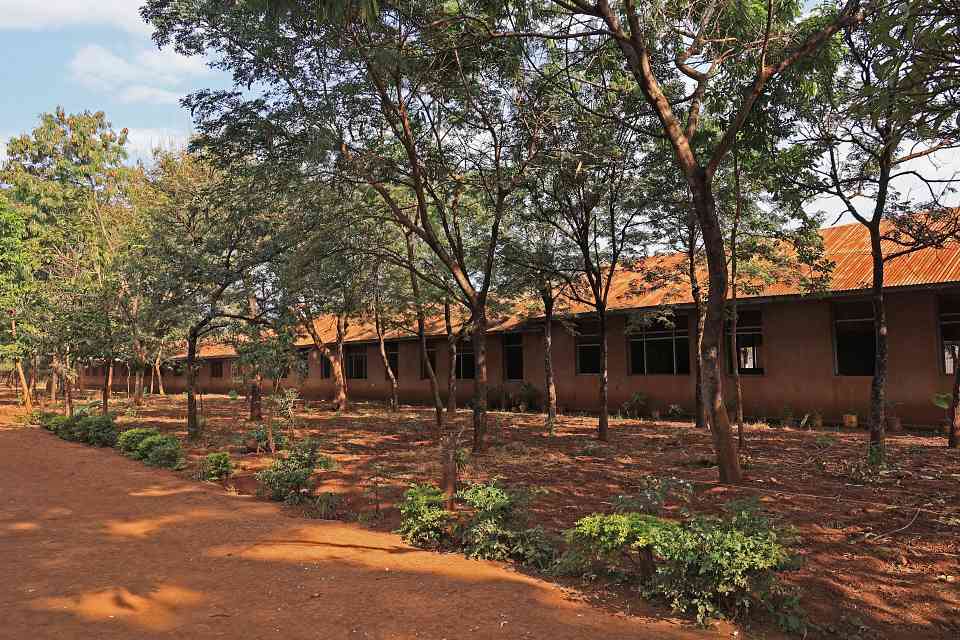
Mpingo trees growing in Moshi, Tanzania. Photo by Allan Blunt.
As part of the conservation focus, we volunteers visited five different schools to plant new mpingo trees, grown as seedlings by the partnership with the African Blackwood Conservation Project. We never knew quite what to expect—hakuna matata—but there was always a general plan. Someone at each school would have prepared the holes, and we, often with some students, would set the trees in the holes. Then we presented a short program for the students, demonstrating clarinet and violin and talking about mpingo trees. Few students had ever heard the instruments before.
Some of our mornings involved visits to other schools where DMI had planted trees in previous years. Because of inattention during the pandemic, many of the trees were quite overgrown. Mpingo wood is very dense and full of thorns, so trimming them was an adventure. The goal is to trim the trees, leaving only the branches that were growing the straightest. It takes 70 to 100 years before the trees grow to a seven- or eight-inch diameter and can be harvested for uses other than firewood or small carvings. However, if raised to maturity, they sell for a good price, which can contribute to community wealth, as well as provide wood for clarinets and fingerboards.
Every Saturday, the DMI volunteers took the students on a field trip to learn more about their country, because few people ever get to travel beyond their own neighborhood in Moshi. The trips also helped the children understand the benefits of sustaining the amazing natural resources of Tanzania. I was only there for one Saturday, and we went to visit a coffee farm and help grind and roast coffee beans. Other field trips included visits to Kiviwama Tree Nursery, Rau Forest, Makumira University, and Arusha National Park.
My first weekend in Tanzania, three other volunteers and I got to go on a three-day safari. We visited two national parks, Lake Manyara and Tarangire, and the Ngorongoro National Conservation Area. The driver of our pop-top Land Cruiser jeep was wonderful, helping us spot wildlife, and he was as happy as we were to sit for twenty minutes watching a troop of monkeys, giraffes, or hippos. We stayed both nights at a very elegant lodge and enjoyed each day to the fullest.
Final Thoughts
The 2023 program was a rebuilding year for DMI. The organization relies on donations of instruments and supplies and depends on volunteer teachers. In past years, DMI has had enough volunteers and full-size instruments to teach at a secondary school, and sometimes these older students get to keep their instruments. This year, we had only small violins. It was a very bittersweet feeling to celebrate the students’ accomplishments in the final concert, and then collect all the instruments, knowing the kids were having to say goodbye to their beloved violins as they were packed away for the school year. Fraterin and Michael are among the locals who could become longer-term teachers. As DMI and other organizations recover from the pandemic, it is my hope that they can secure instruments, funding, and teachers to continue expanding to a year-round program. To read more about DMI, its goals, stories about the people, or to help out, see their website, http://www.darajamusicinitiative.org/.
Before my friend showed me the Facebook posting about the Daraja Music Initiative, I had never thought much about where a fingerboard or an ebony frog comes from, much less what it would be like to teach violin in Tanzania. Seeing how little most people in Moshi have, how hard the people work to earn a meager living, and how eager the children were for the experiences we could offer them, I learned to be even more grateful for all that I’ve been given, just by being born a middle-class American who just happened to choose to learn to play violin in fifth grade. I heartily encourage others to have your own Tanzanian adventure with DMI. Hakuna matata!
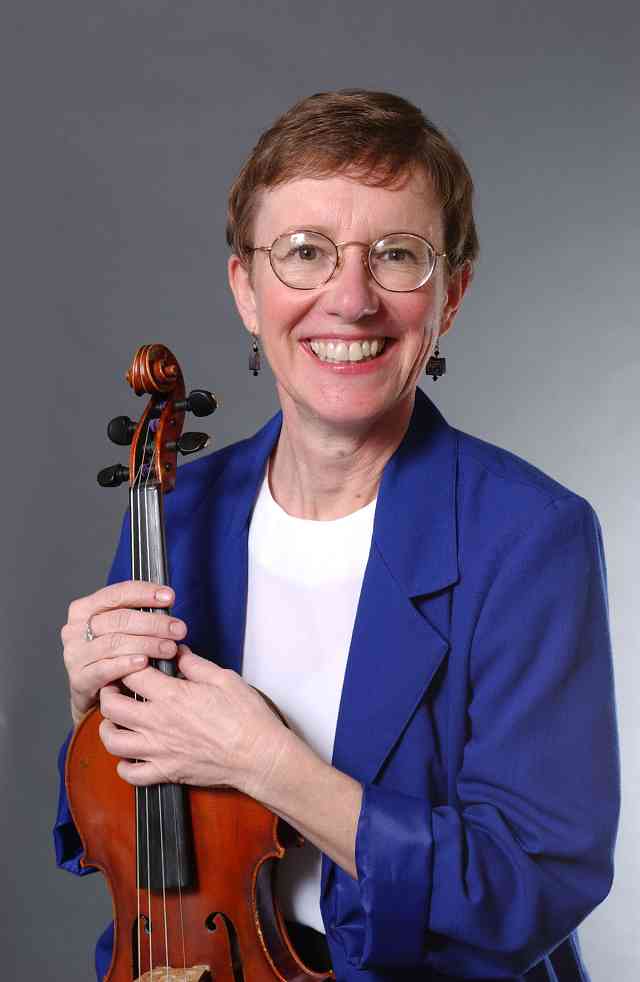
Margaret Schmidt
Margaret Schmidt, Professor Emerita of Music Education-Strings, taught at Arizona State University for 21 years. Prior to her appointment at ASU, Dr. Schmidt was Associate Professor of Music Education and Chairperson of the Music Department at St. Cloud State University. A specialist in string education, she has held public school string positions in Naperville, Illinois, Albuquerque, New Mexico, and Austin, Minnesota. She is the founder and director of the ASU String Project.



